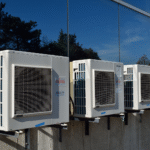Modern data centers face unprecedented thermal challenges as computing workloads continue to evolve and intensify. AI applications, high-performance computing clusters, and increasingly dense server configurations are pushing traditional cooling systems to their limits. What once seemed like a straightforward operational decision has become a critical strategic choice that directly impacts energy efficiency, sustainability goals, and your facility’s ability to support next-generation workloads.
The fundamental question facing data center operators today isn’t just how to cool their equipment, but whether to stick with familiar air-based systems or make the leap to liquid cooling technologies. The cooling strategy you implement today will determine not just your operational costs, but your competitive position in an increasingly compute-intensive business landscape.
The Classic Choice: Air Cooling
Let’s be honest, most of us grew up with air cooling, and there’s something comforting about sticking with what you know. Traditional air-based systems feel familiar because they work alot like the HVAC in your office building, just beefed up for server rooms. You’ve got your computer room air conditioning units doing the heavy lifting, maybe some in-row cooling units for extra precision, and hopefully some hot and cold aisle containment to keep the airflow organized.
The whole system works by pushing cool air where your servers need it and sucking away the hot air before it causes problems. Hot and cold aisle containment makes this way more efficient by preventing that annoying mixing of hot and cold air that wastes energy and creates hot spots.
Why do so many data centers still love air cooling? The upfront costs won’t make your CFO faint, for starters. Your facilities team probably already knows how to maintain these systems, and when something breaks, you can find parts and service pretty much anywhere. There’s also something to be said for the fact that air cooling has been battle-tested in thousands of data centers for decades.
But here’s where things get tricky. Ever tried cooling a rack that’s pulling 30 or 40 kilowatts with just air? It’s like trying to cool a bonfire with a desk fan. Higher-density servers, especially those loaded with GPUs for AI workloads, generate more heat then traditional air systems can handle efficiently. Plus, you need tons of floor space for all that air circulation equipment, which gets expensive fast in markets where real estate costs serious money.
The Challenger: Liquid Cooling
Liquid cooling used to sound like something only the most hardcore data center nerds would attempt. Now? It’s becoming essential for anyone serious about high-performance computing or AI workloads.
You’ve got several flavors to choose from. Direct-to-chip cooling brings coolant right to your hottest components through custom cold plates, think of it as a targeted approach that goes straight to the source. Immersion cooling actually dunks your entire servers in special fluid that won’t fry your electronics but will pull heat away like nobody’s business. Rear-door heat exchangers mount right on your racks to grab heat before it even enters the room.
The physics here are pretty compelling. Liquid can absorb and move way more heat than air ever could, which means you can pack more computing power into less space. For GPU farms running AI training jobs, liquid cooling often becomes the only way to keep things running without thermal throttling that kills performance.
The downsides? Your wallet’s going to feel it upfront. The initial investment can be eye-watering, especially if your retrofitting an existing facility. Integration gets complicated fast, you need people who understand both IT equipment and liquid cooling systems, and that’s not exactly a common skill set. Your facility might need major infrastructure changes for liquid distribution, leak detection, and different maintenance procedures.
Key Factors in Making the Right Choice
So how do you decide what’s right for your situation? Start with rack power density, it’s usually the make-or-break factor. If you’re running standard enterprise servers pulling 10-15 kilowatts per rack, air cooling probably makes perfect sense. Push past 20 kilowatts and your entering liquid cooling territory whether you like it or not.
Think about your energy efficiency goals too. Are you trying to hit specific power usage effectiveness targets? Dealing with sustainability mandates from corporate? Liquid cooling systems can achieve better efficiency ratios, but all that supporting infrastructure might eat into some of those gains.
Budget conversations get interesting because the math isn’t straightforward. Sure, air cooling costs less upfront, but those higher operational costs add up over years of operation. For high-density deployments, liquid cooling might actually save money in the long run, but you need to survive that initial capital hit.
Space constraints can force your hand completely. Got limited ceiling height or structural capacity? Extensive air handling might be off the table. No proper floor drainage or leak containment systems? Liquid cooling becomes a much riskier proposition.
Don’t forget about uptime requirements either. Mission-critical operations need redundancy and failover capabilities that add complexity no matter which technology you choose. The question becomes which system gives you better reliability for your specific situation.
Future growth plans matter more than you might think. If your planning to add GPU clusters or increase server density significantly, designing for liquid cooling from day one might be way cheaper than retrofitting later when you’re desperate.
Why Hybrid Cooling Might Be the Smartest Move
Here’s what many smart data center operators have figured out, you don’t have to pick just one cooling method. Hybrid approaches use air cooling for your everyday servers that run fine with traditional power densities, while implementing liquid cooling specifically for your high-performance clusters, GPU farms, or other heat monsters.
This strategy makes alot of financial sense. You’re not over-engineering cooling for equipment that doesn’t need it, but you’re also not painting yourself into a corner when high-performance workloads come knocking. Plus, you can start with air cooling and add liquid cooling capacity as your needs change, which spreads out the capital investment.
Hybrid cooling works especially well if your running diverse workloads or experiencing rapid growth in compute-intensive applications. You can match your cooling technology to specific equipment needs rather than trying to force everything into the same solution.
Cooling Isn’t Just an Operational Detail, It’s a Strategic Advantage
There’s no perfect cooling solution that works for everyone, and anyone who tells you otherwise is probably trying to sell you something. What matters is picking the approach that aligns with your specific workloads, growth plans, budget realities, and operational constraints.
The organizations that treat cooling as a strategic infrastructure decision rather than just an operational afterthought end up with real competitive advantages. They spend less on energy costs, get better performance from their equipment, and have the flexibility to adopt new technologies when opportunities arise. Whether you go with air cooling, liquid cooling, or some combination of both, make sure your choice supports where your business is heading, not just where it is today.





